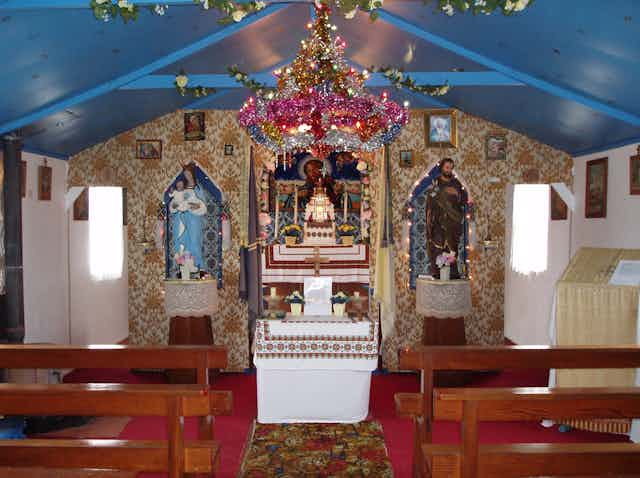On the outside, it is a shabby corrugated iron hut. But 70 years ago, in the aftermath of the Second World War, this small shed in a rural southern corner of Scotland became a place of worship for a group of devout Ukrainian prisoners of war (PoWs). Today it operates as a hub for local community efforts to send aid to refugees fleeing Putin’s invasion, underscoring once more the links between the UK and Ukraine.
The chapel is part of Hallmuir PoW camp, built in 1942 near Lockerbie, to house German and Italian prisoners. During the war years, it was one of hundreds of similar sites which housed enemy servicemen seized across the world.
After peace came in 1945, the German and Italian PoWs were repatriated. Yet Ukrainian troops, mostly captured between 1943 and 1945 whilst serving in the 14th “Galicia” Division of the Waffen-SS, were not so fortunate. Although the the Germans invaded and occupied Ukraine in 1941, the Galicia Division were remodelled as the Ukrainian National Army in March 1945, and by May 1945 more than 8,000 of them found themselves in Allied captivity in Rimini, on Italy’s Adriatic coastline.
Post-war provisions dictated that PoWs who could be deemed Soviet citizens were to be returned to the Soviet Union. However, given the association of these Ukrainian troops with the Nazi regime, near-certain death or hardship awaited them on their return.
The Ukrainian Greek Catholic Church, backed by Pope Pius XII, pleaded for clemency from American and British authorities, arguing the Ukrainian prisoners were “good Catholics and fervent anti-communists”. The Allies yielded, and rebranded the Ukrainian PoWs as “surrendered enemy personnel”, enabling them to avoid Soviet repatriation. Instead they were allowed to choose between resettlement in Canada or the UK.

Life in the camp
By 1947, Hallmuir camp had fallen into disuse. But in May of that year, just over 7,000 Ukrainian captives docked at Glasgow, to be distributed across camps in the UK. Around 450 were transferred to Hallmuir, and the experiences of wartime captivity were soon resurrected. This marked the beginning of a lasting settlement of Ukrainians in the UK.
Occupying 40 accommodation huts, the Ukrainians were deployed by the Ministry of Agriculture to labour on regional farms and in the expansive Galloway forest. Daily life was far from easy, but undoubtedly preferable to the sinister fate which had awaited Ukrainians in the Soviet Union. The prisoners soon began to make an impression on the the camp. They fashioned a garden and orchard, and repurposed one hut into a striking Ukrainian Greek Orthodox chapel.

By 1951, the Hallmuir Ukrainians were permitted to leave captivity. Many opted to remain in the Galloway region, partly captured by the charms of south-west Scotland, and partly due to reluctance to venture back to the Soviet Union. To this day, ancestors of the Ukrainian prisoners are firmly integrated into the local area, and Scotland’s capital, Edinburgh, is twinned with Kyiv.
Preserving Hallmuir
Over the past two decades, there have been efforts to preserve Hallmuir for posterity. Now, just five camp buildings remain on the farm site, of which the Ukrainian chapel is the best preserved. It has been the object of restoration efforts, and now closely resembles its appearance as it was in the 1940s.
The Pufkyj family, direct descendants of one of the Ukrainians who settled near Dumfries, have been instrumental in campaigning for heritage status. In 2021, former Ukraine minister of foreign affairs and current ambassador to the UK, Vadym Prystaiko, paid a goodwill visit to Hallmuir.
In terms of conservation, the uncertain future of the Hallmuir site is just one example of the important historical connections that risk being lost. Without a concerted effort to protect marginalised historical sites in the UK, we risk losing the diverse threads which underpin our society.
History is not just a broad sweep of “great men” and grand narratives. We need the lesser known – and neglected – stories of places like Hallmuir to remind us of the humanity and connection that arise from desperate situations. Just a stone’s throw from Hallmuir is Dunscore, the birthplace of Jane Haining, a Scottish missionary who perished at Auschwitz. These are the wartime stories of the humble figures that so often exemplify courage and resilience. Humanity is a universal phenomenon that transcends national borders.

In an immediate sense, the Hallmuir story reminds us that the Ukraine crisis is not some distant foreign affair: it is very much our concern, and has direct cultural implications for British society. In previous testing times, Britain offered a new home for Ukrainians displaced by conflict. As a new humanitarian refugee conflict looms, we must insist that this happens again in 2022.
In wider terms, Hallmuir is evidence of the many multicultural influences which continue to shape this country. Today, there is a vibrant Ukrainian community numbering thousands spread across the British Isles. But substitute Ukraine for any other nation, and it is possible to find historical links to most pockets of the UK.
This unassuming chapel hut provides evidence of how historical sites sites are tied to current events. Perhaps history does not repeat itself, but sometimes it echoes. Just as it happened during WWII, the freedom of a sovereign European nation is being threatened by a merciless tyrant. Even the smallest connections from 70 years ago show that we are linked by myriad threads, which strengthen in times of hardship and need.

